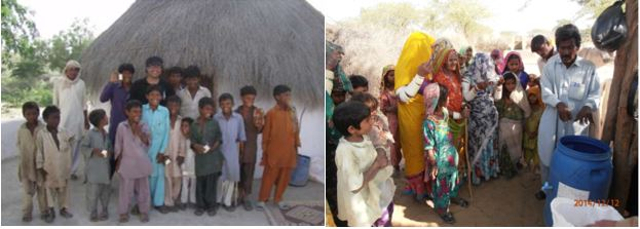Description
The mounting challenges posed by drought are focus areas for Pakistan Water Partnership’s (PWP/GWP-Pakistan) work, particularly in desert areas, which have received minimal attention in the past. PWP’s Desert Development model puts emphasis on livelihood creation, water security, hygiene, and environmental sustainability as a means of improving the quality of life of desert dwellers and their livestock. Drought is an overwhelming concern and Pakistan faces this stress in all three of its deserts, namely Tharparkar, Cholistan and Thal.
Action taken
As part of WACREP funded PWP intervention, a wide range of activities were carried out under Desert Development, targeting two major desert regions of Pakistan: the Greater and Lesser Cholistan Desert and the Tharparkar Desert from September 2014 to November 2015 (14 months). Both of these areas are geographically an extension of the Great Indian Thar Desert in Pakistan. The Desert Development approach consisted of a wide range of activities, carried out in 45 villages of the Tharparkar District housing more than 128,000 people. By improving access to potable water, distributing food and medicines for people and livestock, building capacity in traditional soap-making techniques, and the operation of bio sand filters, entire communities were benefited in various ways. Local village leaders were trained in soap-making and provided bio sand filters. Their increased capacity in these realms allowed them to educate the rest of the community members.
Lessons learned
- In order to ensure water security in drought-affected areas, widespread support by governmental/local agencies should be provided to communities.
- Large scale and widespread capacity building in livestock, forestry, fodder, women rights, and health is needed on a fast-track basis for self-reliance and sustainable development.
- Focusing on home garden and village plant nurseries can augment food security and improve health of community members.
- Training sessions will help reduce exploitation and ensure that dwellers receive fair prices for their products in the market.
- Introducing small-scale, portable solar units to convert brackish water to sweet water can provide an alternative source of potable water and can help communities prevent diseases like stomach problems, which are a result of drinking brackish water.
- Local donkeys could be revived as they are a source of power and can thrive very well on scant vegetation. Such animals can play a positive role, and hence a small equine research centre could be created to further research on improvement of this species.
- The government should commission water interventions like RWH systems, emergency ponds, and small dams to provide safe drinking water. It could further facilitate a focused response from NGOs working in THAR and conduct M&E, so activities can be scaled up.

